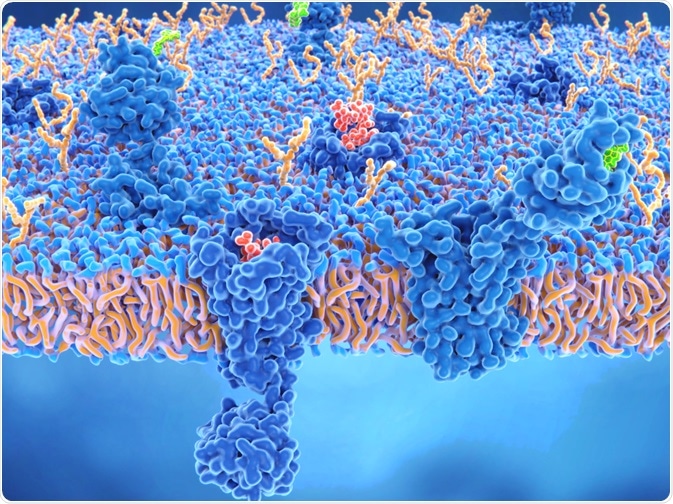The existence of the endocannabinoid system was discovered in the 1990s by researchers investigating the main psychoactive cannabinoid of cannabis, THC.

Image Credit: Juan Gaertner/Shutterstock.com
Since then, there has been ongoing research done to elucidate the functioning and biological basis of the system. Understanding of the endocannabinoid system, which regulated the response to cannabinoids, is essential due to the increasing legalization of cannabis.
Studies into the impact of cannabinoids within humans will lead to insight into risks associated when using cannabis and cannabinoid products recreationally or for medical purposes, influencing the development of more effective treatments and prevention of addiction.
Currently, there is research focused on understanding how the endocannabinoid system can be exploited to treat disease and illnesses.
What we currently know about the endocannabinoid system
The functions that the endocannabinoid system is responsible are known within literature, such as; influence of appetite, cardiovascular system function, chronic pain, immune system responses, memory, metabolism, mood, motor control, pleasure/reward reproduction, skin and nerve function, stress, and fertility, and sleep, however, this may not be a comprehensive list.
The system is activated by introducing cannabinoids into the body and constantly active due to a role in maintaining homeostasis particularly in leptin-related appetite regulation.
Three main components together make up the endocannabinoid system; endocannabinoids, receptors within the nervous system and enzymes that catalyze the breakdown of endocannabinoids and cannabinoids.
The endocannabinoid system and cannabis research
Cannabinoids directly interact with the endocannabinoid system. The effect of THC, the main psychoactive cannabinoid in cannabis, impacts the endocannabinoid system is well established.
Studies have shown that THC mimics the actions of endocannabinoids by interacting and binding with the endocannabinoid receptors. THC can interact with the two types of cannabinoid receptors that are present in human’s endocannabinoid.
THC interacts with both the CB1 receptors that are located within the central nervous system and the CB2 receptors in the peripheral nervous system, digestive system, and specialized cells in the immune system. THC can activate both of these receptors resulting in the influence of the entire range of processes that these receptors are involved in which affect both the body and mind.
In some cases, THC can induce pleasurable effects because of its influence on these receptors, such as pain reduction.
In other cases, it can initiate feelings of anxiety and paranoia. Research is currently underway exploring how synthetic THC cannabinoids can be produced, activating these receptors in specifically beneficial ways.
Cannabidiol (CBD) is the other main cannabinoid found in cannabis. The impacts of CBD on the body are different from THC as CBD is not psychoactive. Generally, it is believed that unlike THC, CBD does not usually have negative effects.
Currently, scientists are aware that CBD does not activate CB1 and CB2 receptors in the same way THC does, but the underlying mechanisms remain unclear. Research continues to investigate the effects of CBD. Currently, it is theorized that CBD prevents the breakdown of endocannabinoids, resulting in the cannabinoids remaining active in the system for longer and inducing increased effects in the body.
Another possibility is the presence of an undiscovered receptor in the endocannabinoid system. Although the exact mechanisms are currently under investigation, CBD has been found to reduce anxiety and nausea.
The endocannabinoid system as a therapeutic target
There is an increase in research focused on utilizing the endocannabinoid system as a therapeutic target. Sativex, a plant derived cannabinoid is approved in Canada for treatment of pain in multiple sclerosis patients and spasticity.
Current investigations are focused on developing drugs that act as CB1 receptor antagonists (inhibitors) which may have therapeutic potential in obesity, smoking cessation.
Therapeutic applications for the CB2 receptors are currently not clear and primarily related to neurodegenerative disorders, such as Alzheimer's and Parkinson's diseases and immune regulation.
References:
- Kunos, G. (2007). Understanding metabolic homeostasis and imbalance: what is the role of the endocannabinoid system?. The American journal of medicine, 120(9), S18-S24.
- Lange, J. H., & Kruse, C. G. (2005). Keynote review: Medicinal chemistry strategies to CB1 cannabinoid receptor antagonists. Drug discovery today, 10(10), 693-702.
- Pacher, P., Bátkai, S., & Kunos, G. (2006). The endocannabinoid system as an emerging target of pharmacotherapy. Pharmacological reviews, 58(3), 389-462.
- Pagotto, U., Marsicano, G., Cota, D., Lutz, B. and Pasquali, R. (2006). The Emerging Role of the Endocannabinoid System in Endocrine Regulation and Energy Balance. Endocrine Reviews, 27(1), pp.73–100.
Further Reading
Last Updated: Mar 18, 2020